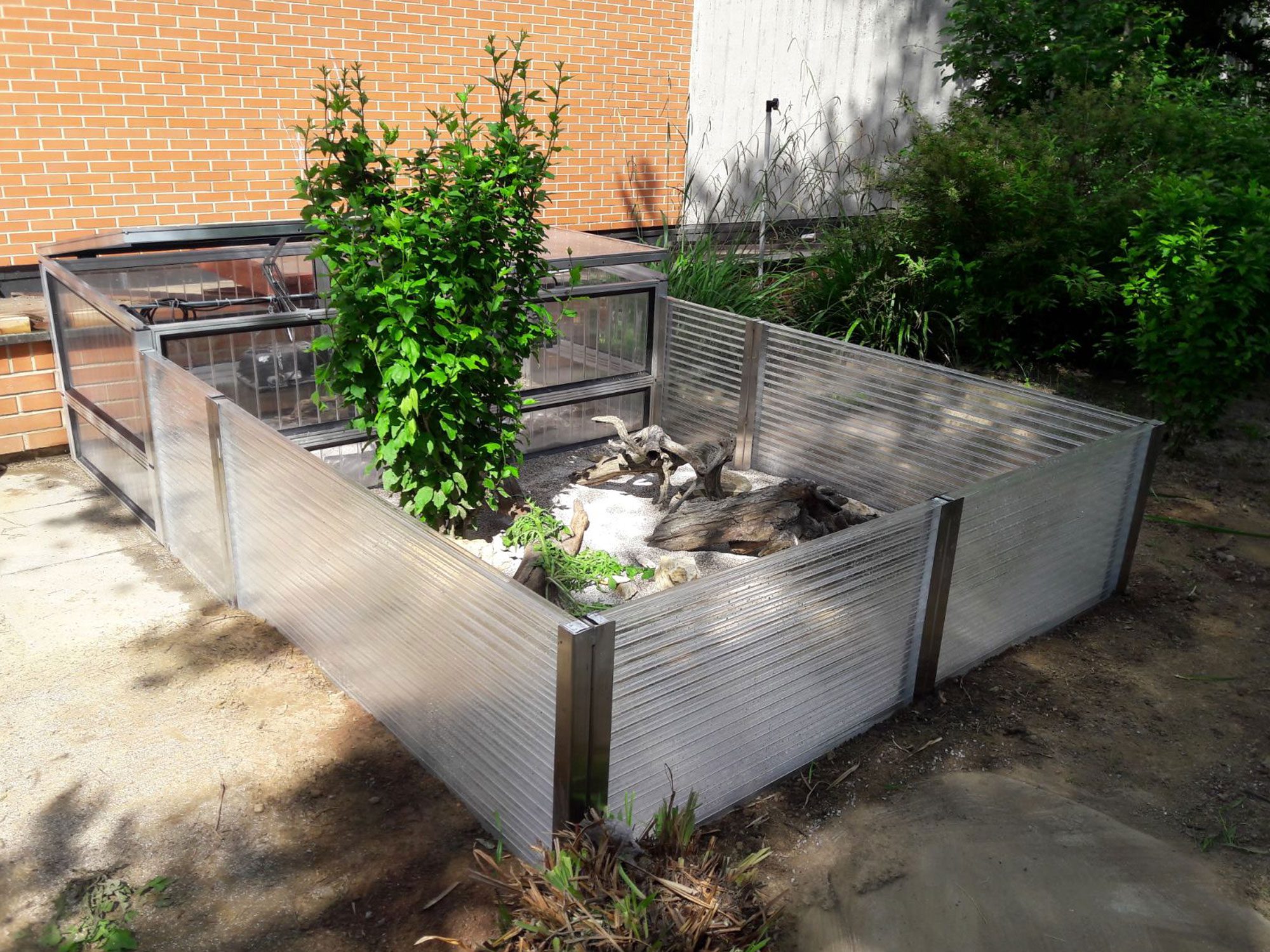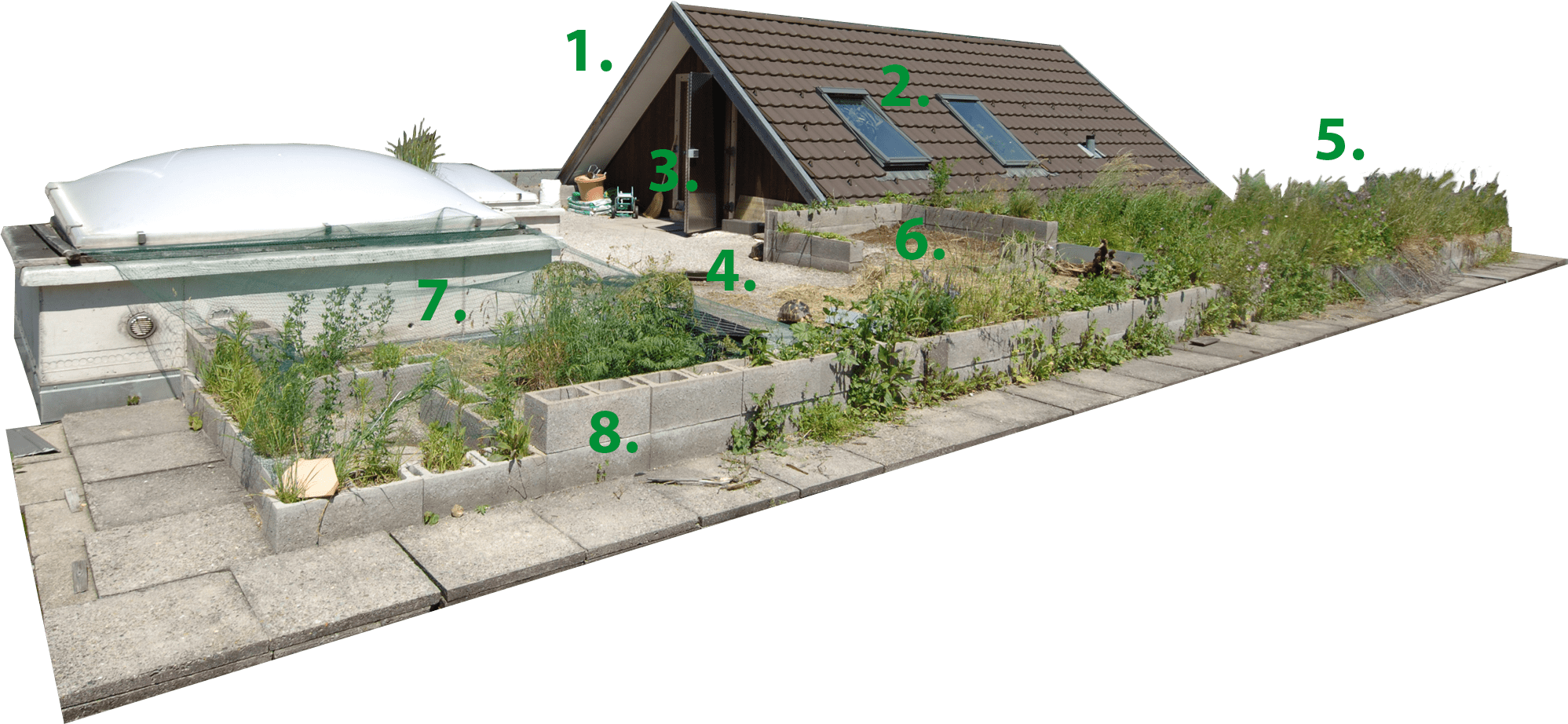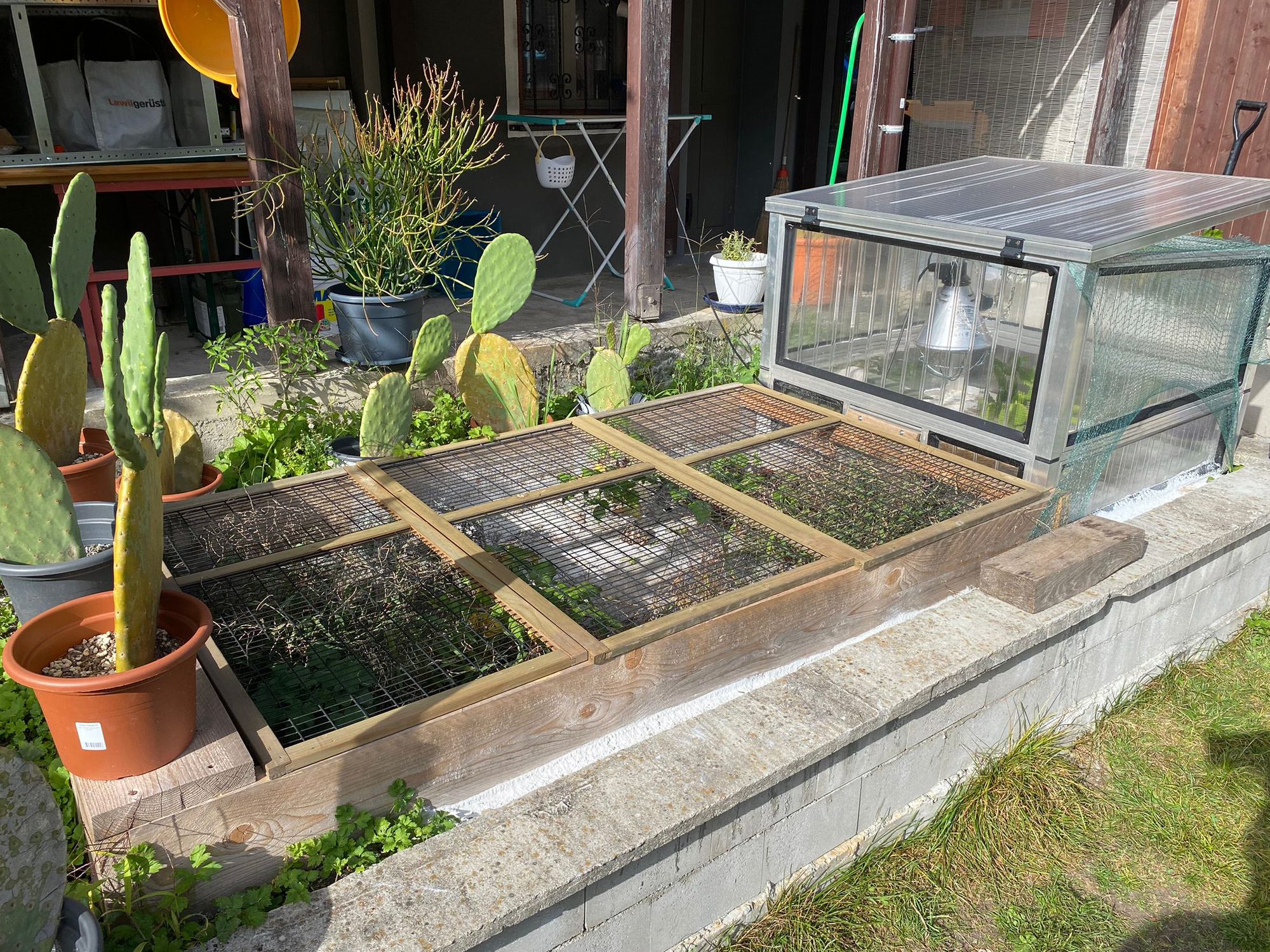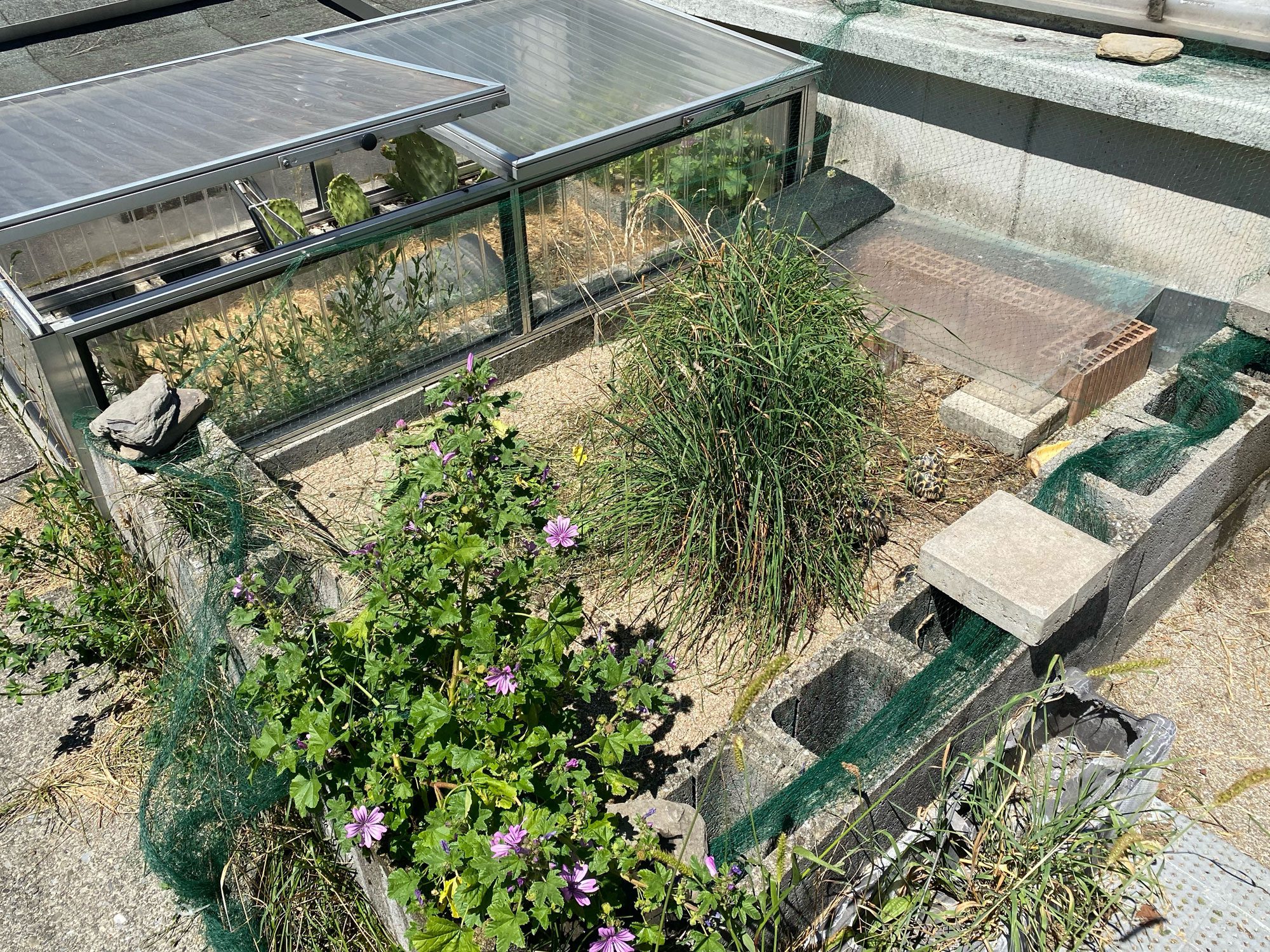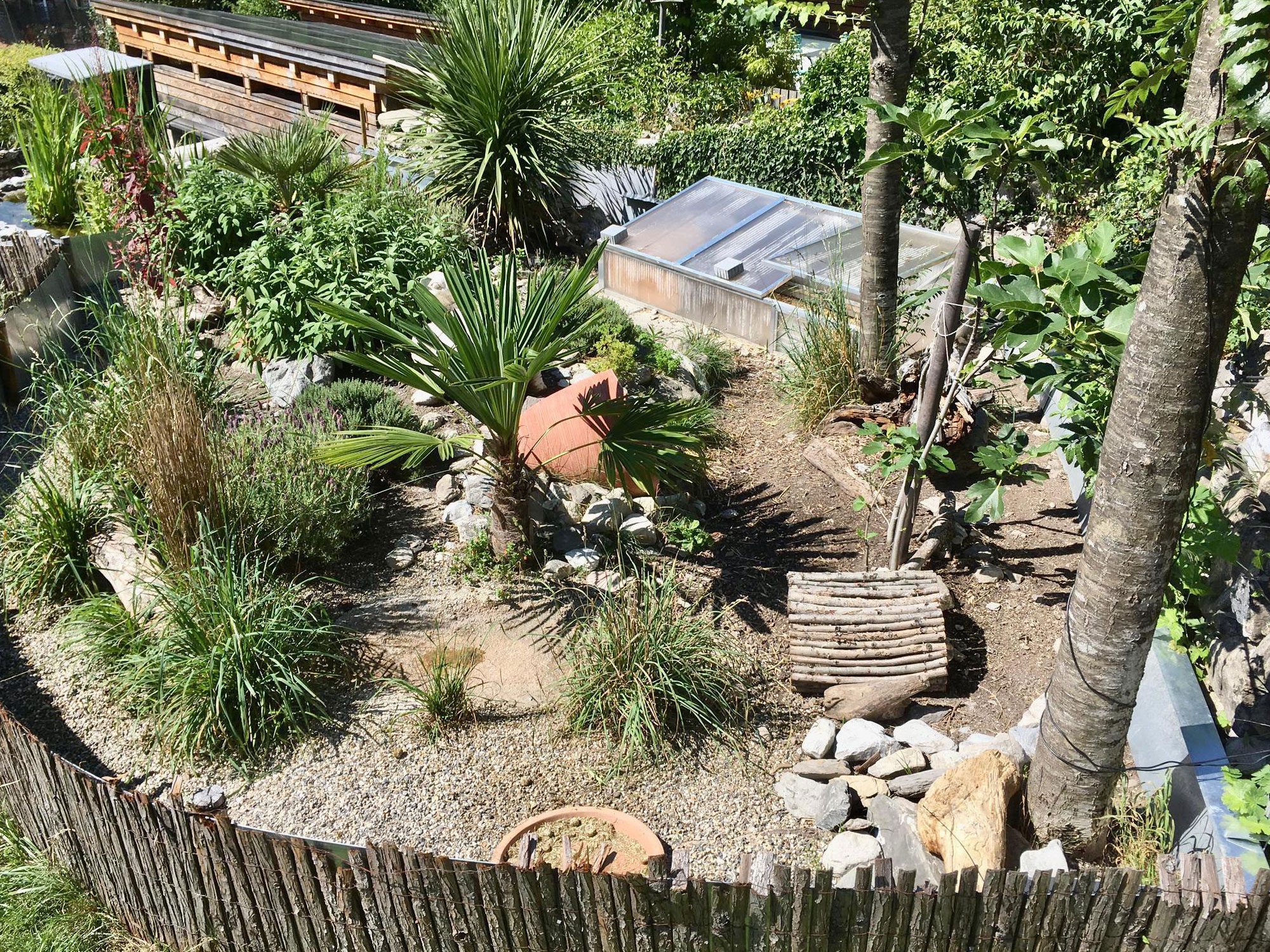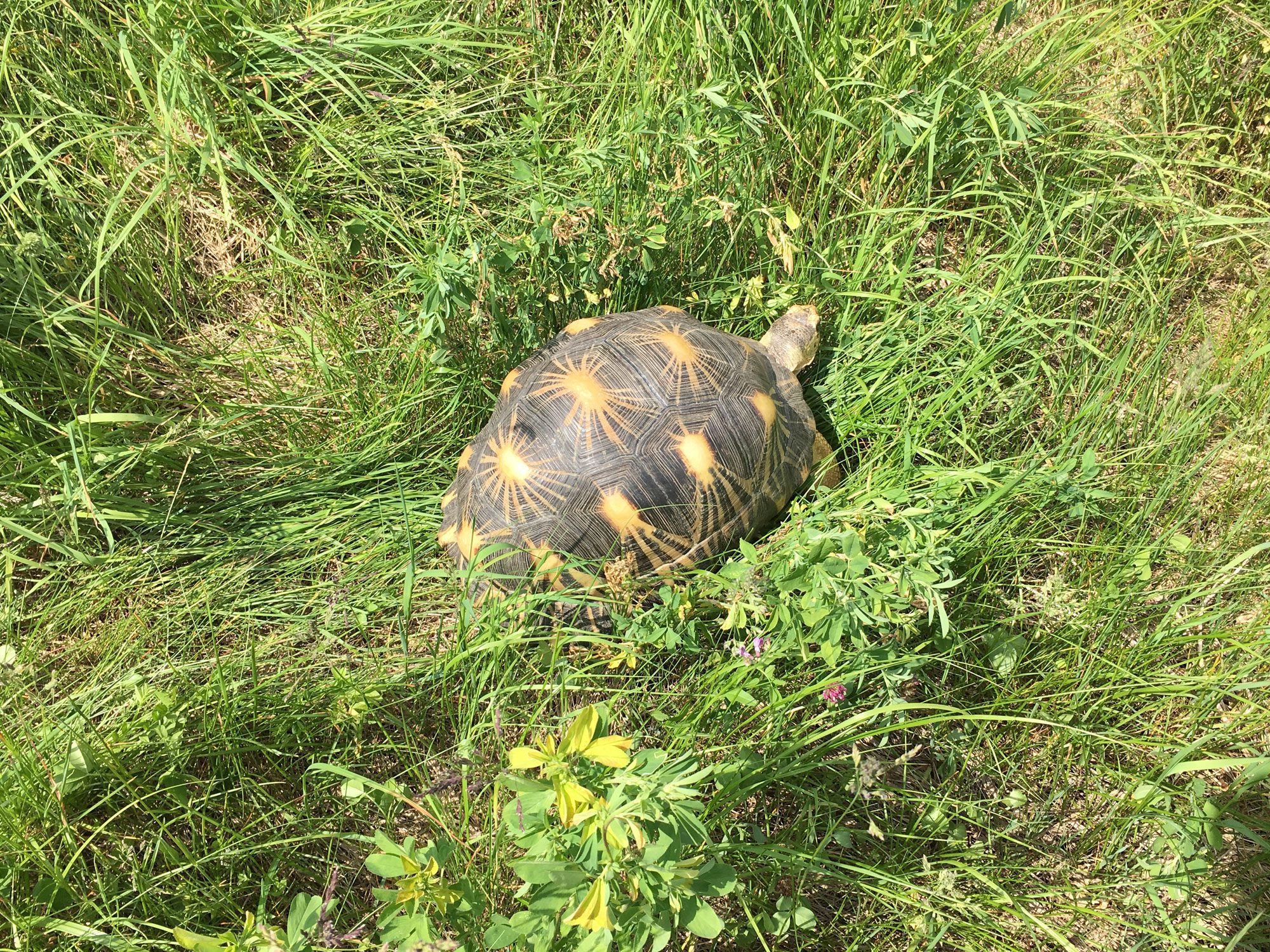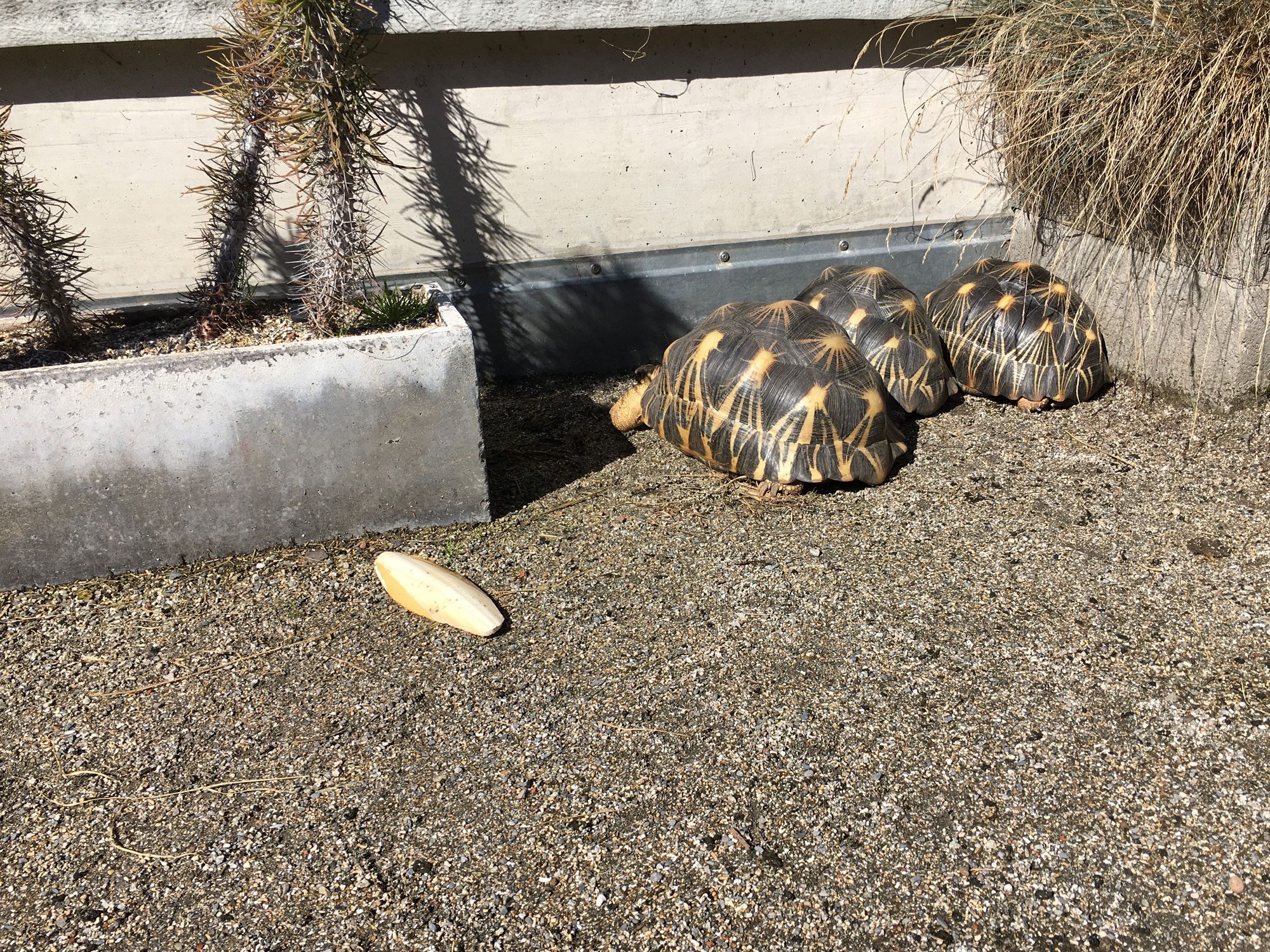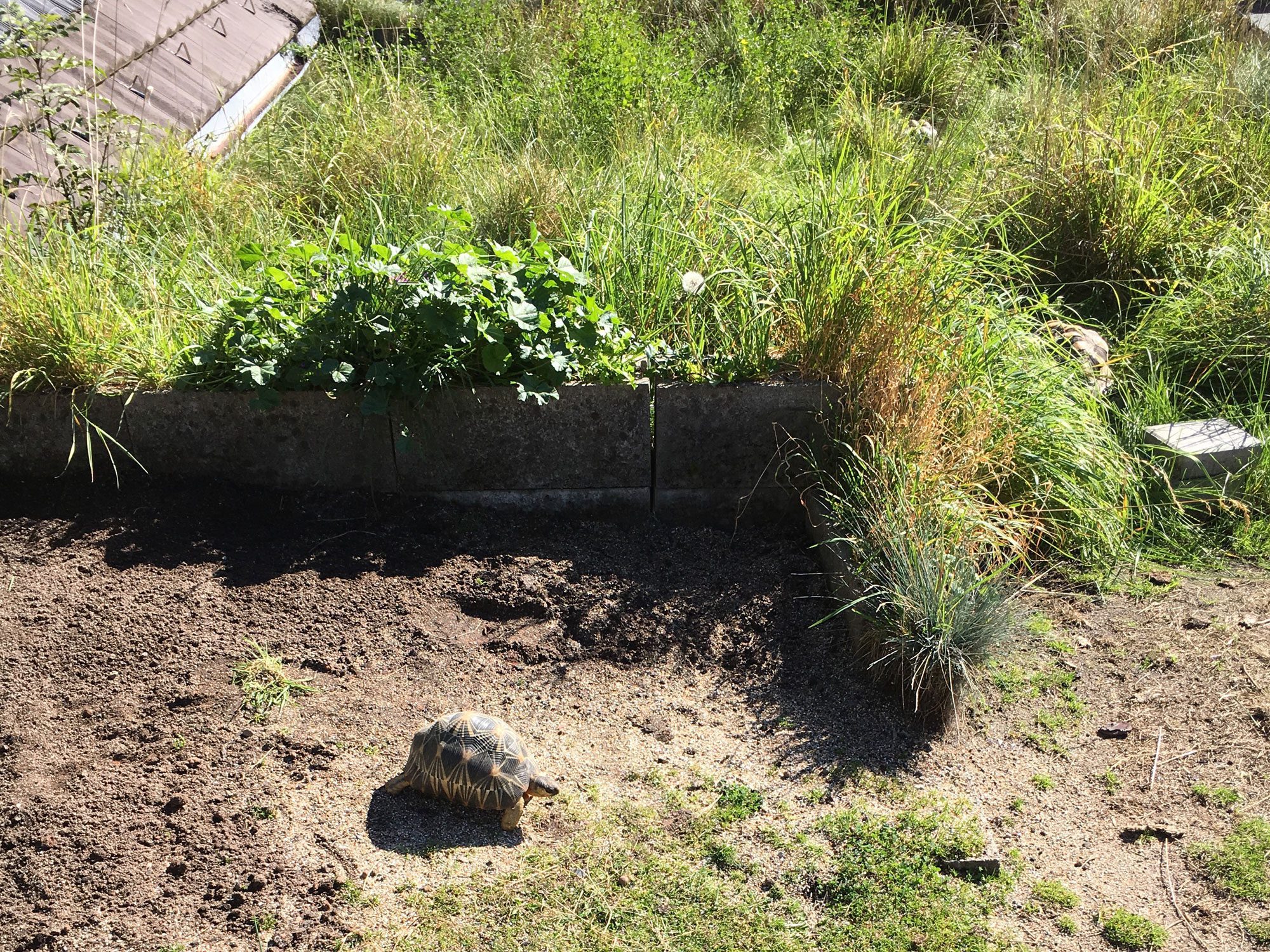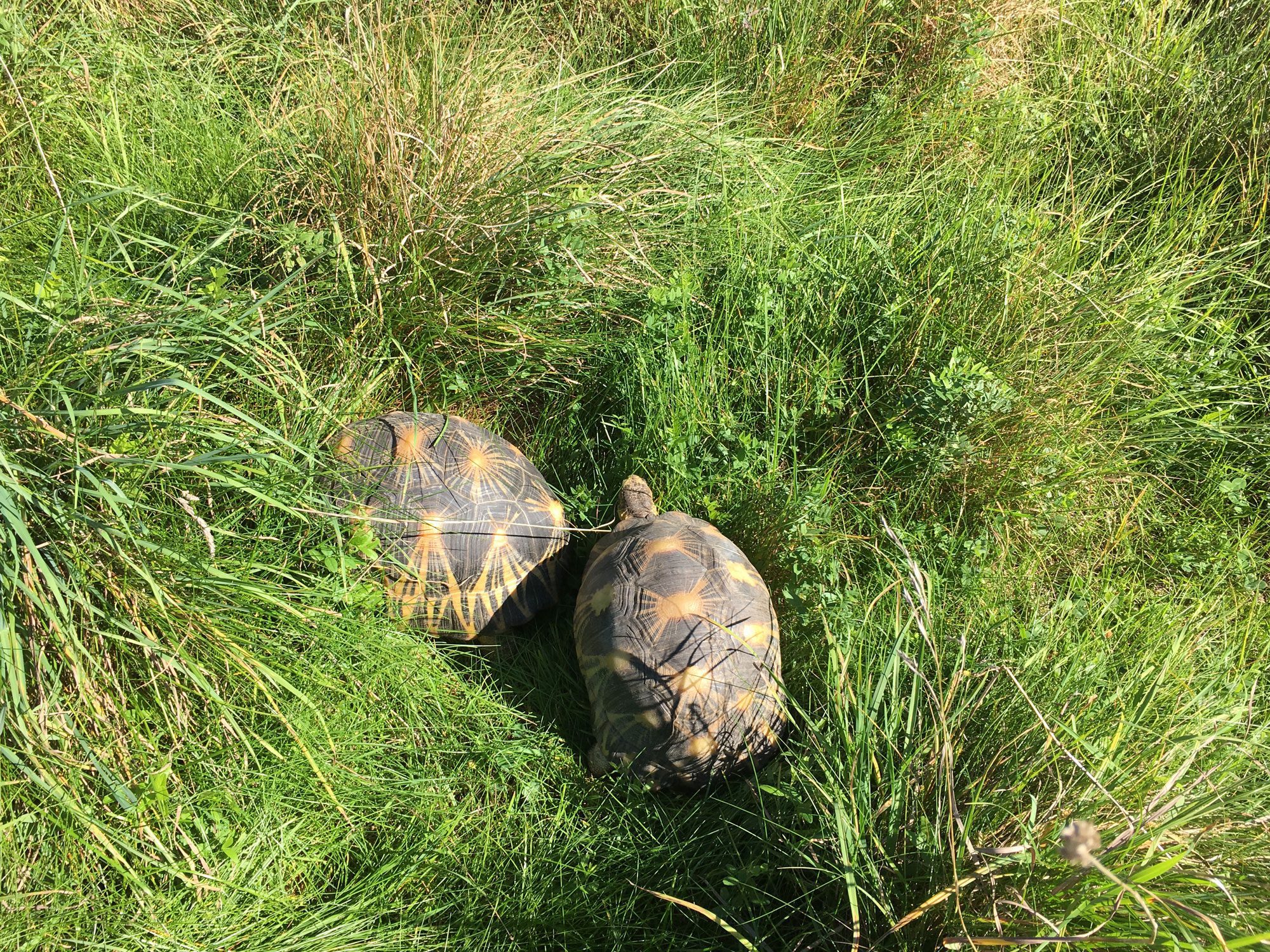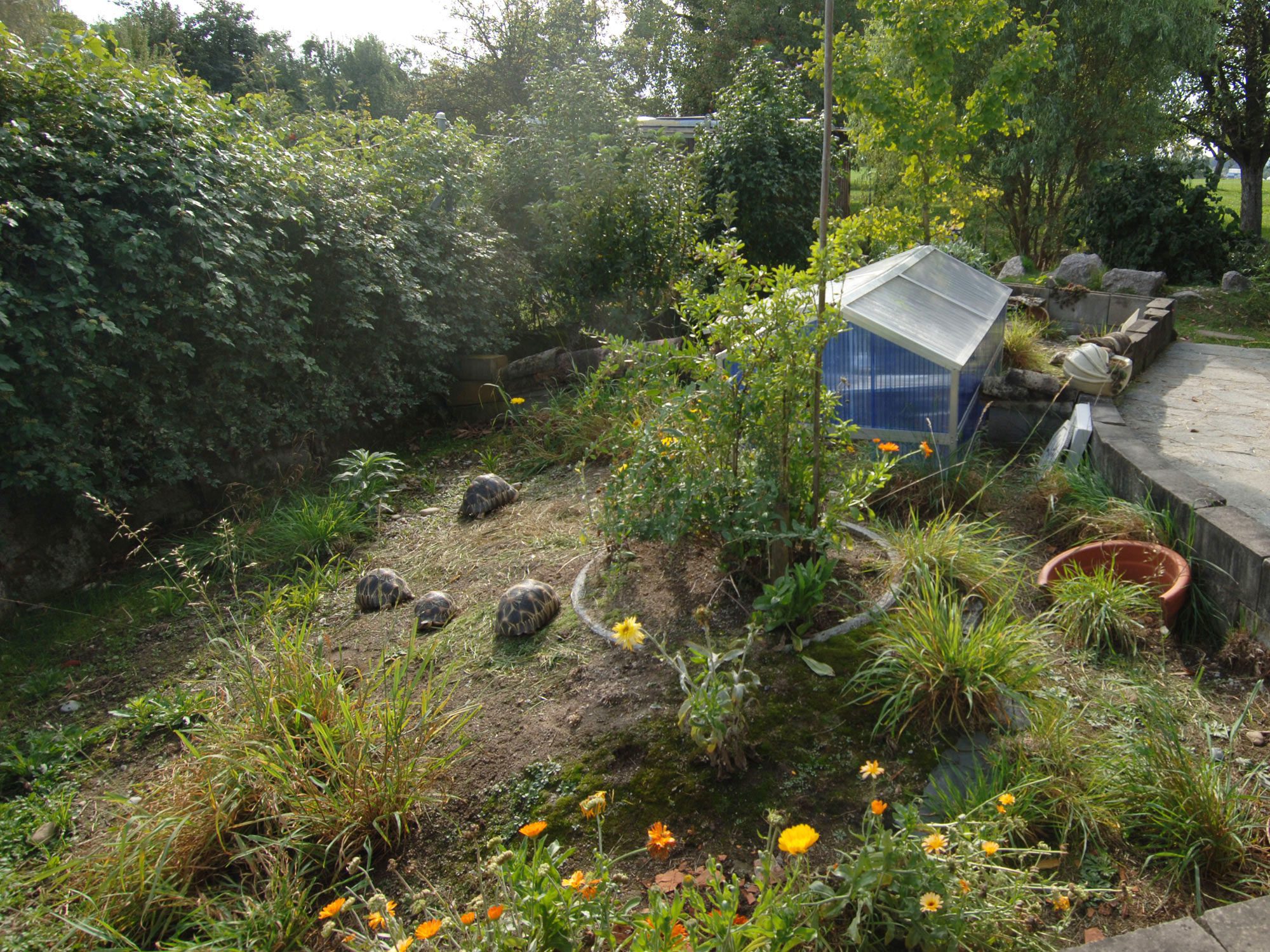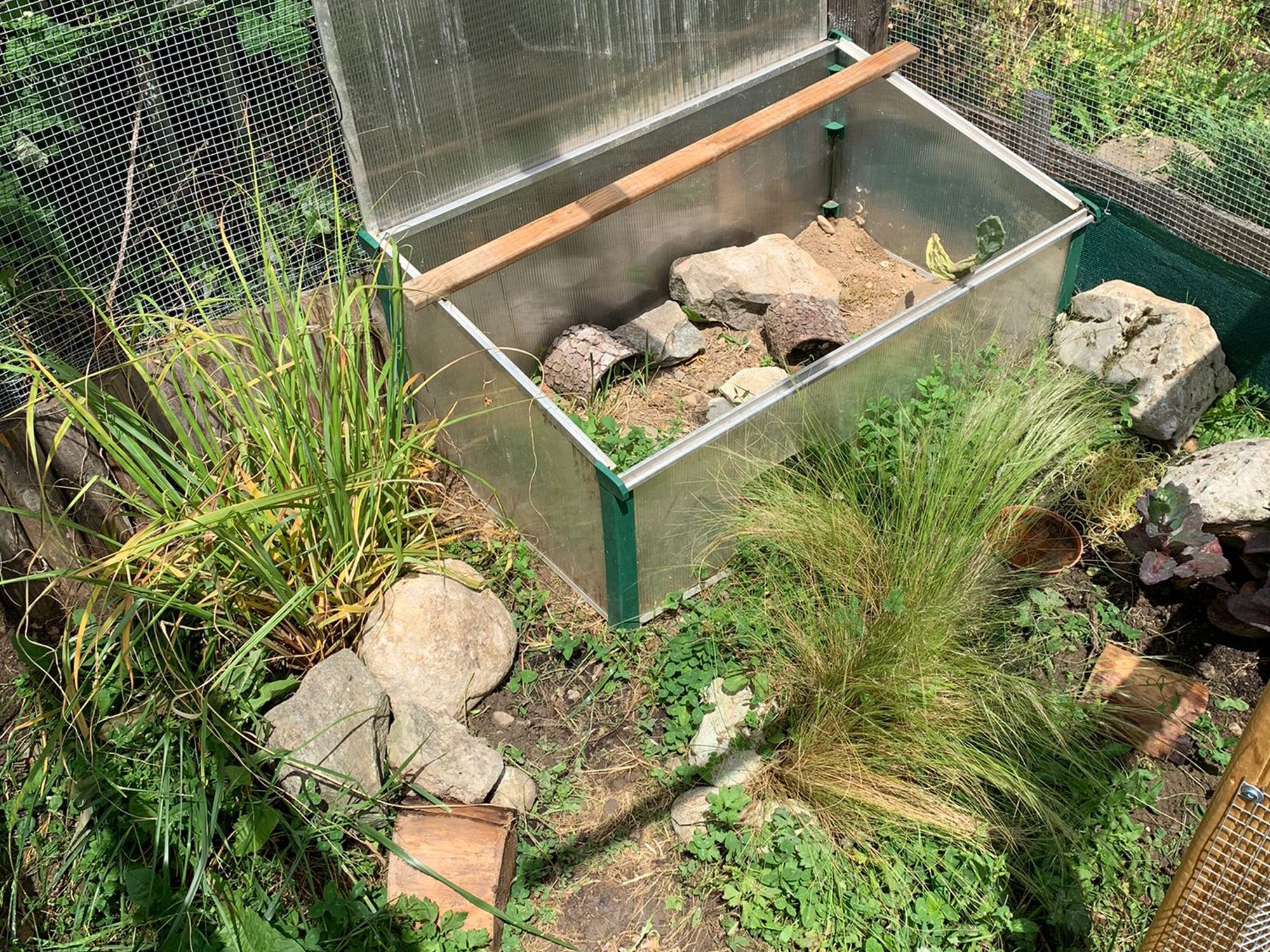Outdoor facilities
Tortoises have physical and psychological needs that are often completely neglected by us humans in keeping them. Tortoises want to sunbathe, run around in the fresh air, forage, graze in the field, hide, and communicate and interact with conspecifics in tortoise fashion. All of this is usually limited in indoor facilities. The whole repertoire of tortoise needs can only be lived out and satisfied in outdoor facilities close to nature.
We can not emphasize it enough: A Radiated Tortoise always belongs in a species-appropriate outdoor enclosure in sunny weather! Be generous and offer your Radiated Tortoise in the sunniest place in the garden a natural and well-structured outdoor enclosure with a heatable shelter. She will thank you with health and a long and happy turtle life!
Base the design of the outdoor enclosure on the natural biotope of Astrochelys radiata. Light, dry and sunny sandy areas alternating with grasslands and planting of low shrubs are preferred by Radiated Tortoises. The terrain should generally be uneven, varied and well structured. Stones, roots, branches and tree trunks serve as visual protection and scratching opportunities for the tortoises. Planting with suitable food plants is not only a visual embellishment, but also very practical.
Although compared to European tortoises, Radiated Tortoises do not climb well or dig significantly, adult specimens are very strong and can easily push away or depress unstable and loose enclosure boundaries with their body weight. A solid and robust fencing of the outdoor enclosure with 40-50 cm high hollow breeze blocks, natural stones, concrete/wood palisades or other masonry elements is highly recommended. Mesh-like and transparent fencing materials, without complete visual protection (glass, lattice, wire, slat fences, etc.), irritate tortoises in their perception of boundaries and are unsuitable due to the risk of injury.
Shelters
The climate of a Central European summer is on average too cold for tropical tortoises, too rich in precipitation and definitely has too little sunshine duration. It is therefore necessary to resort to technical aids in the outdoor area to create dry, light-flooded areas with increased temperatures. A cold frame or greenhouse is the easiest way to achieve this. The greenhouse effect immediately raises the temperature when there is little sunlight, and good insulation ensures that heat is well retained inside at night when outside temperatures are cool. In order for the vital UV rays to reach the turtles through the cover every day, the entire shelter should be made entirely of Alltop (Plexi or acrylic glass) exist. For radiant tortoises, it makes sense to use additional UV lamps despite UV-transmissive glazing in order to achieve the necessary light and radiation levels even on cloudy and rainy days. A simple electric or commercial greenhouse heater will provide a comfortable base temperature during the wet and cold transition period, both day and night. It is important to install a simple, automatic, oil-pressure window opener that provides adequate ventilation by raising the skylight and prevents the cold frame from overheating. Depending on the size of the cold frame or greenhouse, several fans may be necessary, especially in summer. Shelters can be built yourself from Alltopplatten or purchased ready to use in various sizes and designs from the following Swiss suppliers: Neogard, Botanicum, Free
Cold frames or greenhouses equipped with HQI lights and a heater extend the stay of tropical tortoises in our latitudes in the outdoor area many times over. The use of shelters is therefore an indispensable aid in the keeping of tropical tortoises.
Our outdoor facility
The entire south-facing outdoor area is fenced with a 50 cm high wall made of fetch and plantable breeze blocks and covers 100m2. In summer, the sun shines on the outdoor area from as early as 8 am. The facility is divided into two areas, a dry, sandy area and a green grassy area.
The first, dry area consists of a sandy landscape interspersed with shell grit, where only sparse vegetation thrives. Here it has flat stones, calcareous boulders and a few excavated rootwads that serve as "scratching trees" for the tortoises. This area always dries quickly after rainfall and is a popular place to sunbathe and warm up. During the transitional periods, in spring and fall, we reduce the outdoor area to this dry, sandy area by separating it with wooden boards. From here, the animals can also independently access the indoor enclosure via a flat ramp. Because the indoor enclosure is directly connected to the outdoor enclosure and the animals can decide independently whether they want to stay in the protected indoor area or outdoors, we do not need additional shelters for the adult animals.
The second, green area consists of an artificially created meagre meadow, where all kinds of grasses and herbs thrive. Seasonally, the Radiated Tortoises graze the entire area completely. In order for the forage plants to recover and grow again, we regularly cut off the grassland again. However, some forbs are so eaten and plucked out that they must be reseeded from time to time. The animals also like to stay in this pasture area in midsummer and like to hide under large grass clumps and shady bushes. During our vacation absence, we make sure that the rough pasture is high and full of fodder plants, so that the vacation replacement does not have a big effort with the fodder procurement.
Both in the dry area and in the meadow, it has generous, buriable egg-laying sites for the females in the sunniest places. The outdoor enclosure is designed to separate individual pairs or the sexes from each other. The smaller outdoor enclosures for the young animals are separated from the enclosure for the adults. For the rearing of the young animals, additional heatable shelters made of alltop are required.
Species-specific examples of outdoor facilities
In the following picture carousel you will find some examples and impressions of natural and species-appropriate outdoor facilities for ray turtles for inspiration. In order to show a wide and representative variety of species-appropriate outdoor facilities for the radiata community, we would be very pleased to receive further picture contributions. All contributions with at least 2000 x 1500 pixels (width x height) can be published with name and copyright. We thank all ray turtle keepers for their kind support!
FAQ on the subject of outdoor enclosures
Radiated tortoises always belong in an outdoor enclosure during the warm season, in sunny and dry weather! Provided that the sun is shining, the outdoor enclosure is located on a southern exposure and the animals can warm up in a heated cold frame or greenhouse, radiated tortoises are allowed into the outdoor enclosure already from 15°C outside temperature. Only during longer periods of cold and wet weather and low temperatures should the radiated tortoises be kept exclusively in heated, enclosed shelters or in the indoor enclosure.
If the sun is shining, we let our animals already at the beginning of March for a few hours in the outdoor enclosure, so that they can refuel extensively UV light and fresh air. Over midday it may then have mild temperatures of 15 to 20°C. Sometimes there is still some snow in the outdoor enclosure, but this does not seem to bother the animals. At the latest from 16 o'clock all animals must be again in the heated turtle house. The night is always spent in the transitional periods in a heated and protected indoor!
Warm and dry summers our radiated tortoises are allowed to spend day and night in the outdoor enclosure. In midsummer, all lights and heating elements in the cold frames and in the indoor enclosure remain switched off. The roof flaps of the cold frames for the hatchlings are then always open to prevent overheating. In summers with tropical nights, we also close the entrance to the indoor enclosure for the adult turtles, so that they can spend the night under bushes in the outdoor enclosure as close to nature as possible.
In order to benefit optimally from the natural sunlight, we also try to allow the stay in the outdoor enclosure as long as possible in autumn. If the weather remains sunny and dry, ray turtles can make forays into the outdoor enclosure during the day until the end of October. However, the animals should then always spend the nights in heated and locked shelters. At the latest when the power of the sun decreases, the outside temperatures drop below 15°C and there are persistent wet and cold weather conditions, radiated tortoises must be brought into the heated winter quarters until the next spring.
This question is very difficult to answer, because an enclosure for a wild animal can never be big enough. We always admire and are very happy about the loving generosity of individual turtle keepers who provide entire indoor spaces with adjacent gardens for their few animals and spare no expense and effort for the well-being of their turtles.
Radiated tortoises are very active tortoises with a great need for exercise. As a rough rule of thumb, you can assume that the mass for an indoor enclosure is at least should be 10x the carapace length in length and width. For an outdoor enclosure 20x the carapace length in length and width. For each additional animal 2x the carapace length in length and width. These specifications should be not be undercut! Of course, the enclosure sizes must always be expanded with the growth of the turtle. The enclosure size should always be chosen sufficiently large, so that the turtles can find different light and temperature zones in it.
Basically, radiated tortoises are individualists and roam alone and independently through their respective territories. They are not dependent on permanent, lasting, social contacts with conspecifics. However, seasonally, e.g. during mating season or at suitable water, feeding or sunning places, ray turtles meet conspecifics again and again and then show a species-specific, interactive social behavior. For the attitude in human care this means that one can hold radiation turtles over a longer period and above all seasonally quite individually. However, it would be species-appropriate to allow them contact with conspecifics from time to time. Astrochelys radiata is a rather peaceful tortoise, so both males and females can be kept together in small groups without any problems. However, when keeping a group, always make sure that there is enough space with possibilities for escape and separation! With regard to the preservation of the species, the striving for intact breeding groups seems to be quite reasonable.
Hatchlings of radiated tortoises often gather closely together in hiding places in the rearing tanks, which sometimes gives the impression that the animals also seek physical proximity to conspecifics. Whether group gatherings of hatchlings also occur in the wild, e.g. under decaying leaves in dry forests, is not known. This could also be rather coincidental, because good, air-conditioned hiding places are simply popular and in demand in the wild as well.
Attention: Although Astrochelys radiata shows good social compatibility in most cases, we strongly advise against socialization with non-species turtles! Astrochelys radiata has a particular hypersensitivity to certain microorganisms foreign to the species. If these are taken up in excess, it can come to the displacement or to the death of the intestinal flora. The immune system is thus considerably and permanently weakened and chronic and insidious inflammation of the gastrointestinal tract can occur. These foci of inflammation can also spread throughout the body and lead to generalized organ failure. Presumably, the low tolerance of Astrochelys radiata to alien microorganisms is related to the endemic lifestyle and the inhabitation of a very special, limited, ecological, niche.
Also, do not buy turtles from mixed-race stocks, because they may already be infected with various carnivorous pathogens! Please note that a socialization of different species is always an expression of limited space and ignorance of individual needs. A socialization creates not only an increased risk of contamination but also additional and unnecessary stress for the animals.
Attention: Radiated tortoises originate from a subtropical climate zone. Their body has therefore no physical adaptation and prerequisite to survive a seasonal cold drought, such as European tortoises hold. Attempting to hibernate a radiated tortoise will end fatally for the animal! Please inform yourself before the acquisition in detail about the needs and keeping conditions of these animals!

